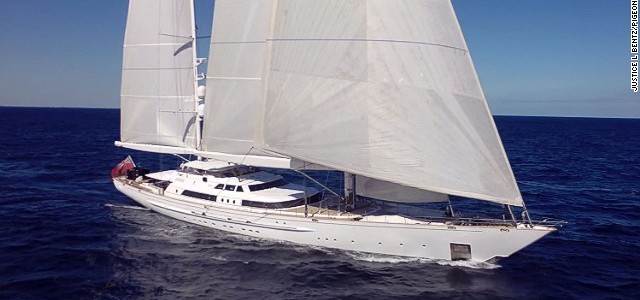Here is a great story from CNN By Ollie Williams, the aerial shot from the drone is really impressive in this video.
Justice L Bentz, 26, lives in Antigua and shoots video profiles of some of the world’s most expensive private yachts.
Not a bad life. But it does come at the cost of wearing a black bag on your head.
“Sometimes, I fly the drone with my head in a trash bag so I don’t get salt spray from the sea on my equipment,” Bentz explains.
“I’m inside the bag, looking at my monitor and basically playing a video game — watching that screen and securing myself so I don’t get thrown around. We go out in the craziest conditions, and the Caribbean winds are really strong.”
If Bentz isn’t the most appealing sight, out on deck in a black bag, his footage is a different story.
Drones have revolutionized what is possible with a camera, but rarely does the end product match this vista of superyachts and Caribbean seas.
“It’s just a perspective you never really see,” says Bentz. “You can either charter a helicopter to come out for an hour for a thousand euros, or I can come out.
“How much do I cost? It really depends on what you want. In some cases, it’s more. But I can get shots and angles a normal helicopter can’t get.
“On the low end, I’m putting about $3,500 in the air. On the high end, up to $35,000. That
would be an octocopter with a Canon 5D camera and a three-axis stabilized gimbal, with a two-man operation.”
Bentz began flying drones as a hobby, then developed a passion for yachts when he spent two
years working on board the 88m-long Maltese Falcon, one of the largest private yachts in the world.
All of the technology he uses is custom-built, based on skills he picked up following in his brother’s footsteps as a child.
Older brother Tyler was one of the early pro video gamers, picking up awards — and tens of
thousands of dollars — as a professional Quake 3 player at the turn of the millennium.
He now works with Alan Karol, a 31-year-old Polish cinematographer, on larger projects — of
which there are many in a Caribbean racing season teeming with stunning yachts and proud owners.
“People spend this crazy amount of money to have everyone come and race in St Barts or Antigua,” says Bentz, “so they want something everyone can relate to and enjoy having.”
Drones are not limited to the rarefied air of the superyacht club.
Some of the world’s leading sailing organizations have been experimenting with similar
technology in the hope of transforming the way the sport is shown on TV.
“If we don’t have a TV viewer-ready product, where does that put us in our livelihoods here?
We’ve got to get on board,” says Ben Remocker, who works with the 49er sailing class.
Remocker has been at the forefront of plans to launch a new “theater-style” version of sailing, which sees races take place along short, compact courses — making the action much easier to shoot, and simpler to show on TV.
He argues that’s vital for the sport’s future, in a world where Olympic sports are judged on
their ability to captivate a global audience.



















